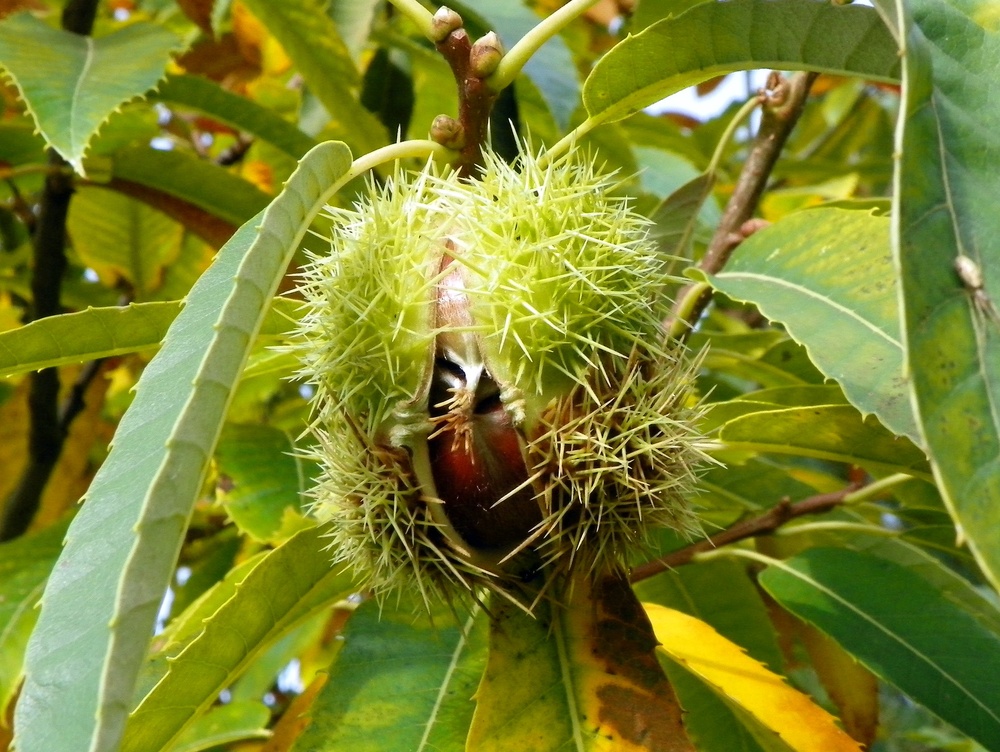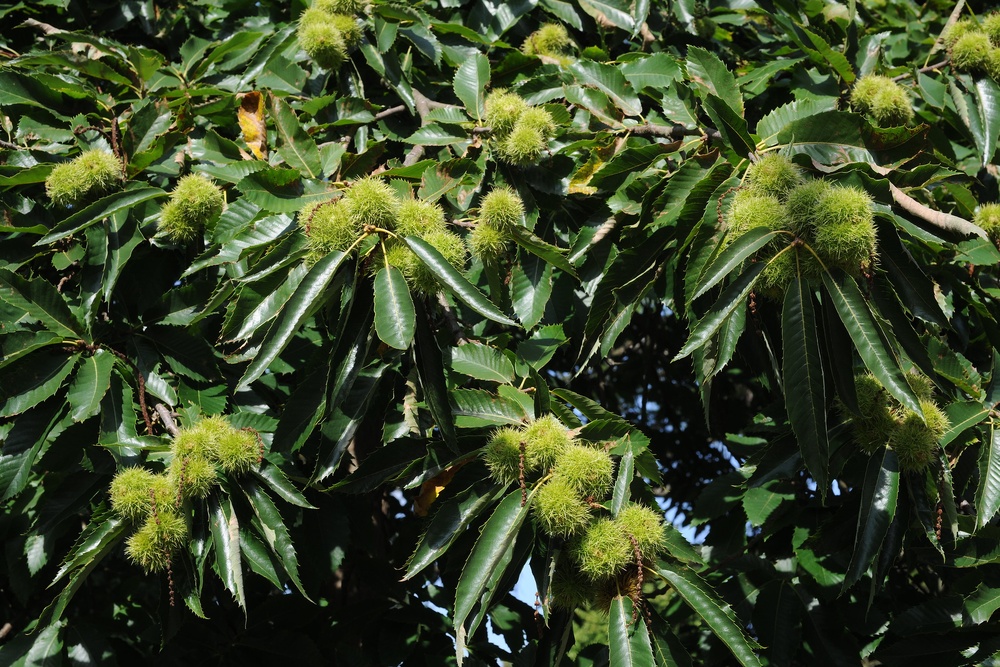Castanea sativa
Tamme kastanje / Sweet chestnut, European chestnut
Fagaceae (Napjesdragersfamilie)Africa (north), Asia (west), Europe (south)

Edible plant part (1)
Nuts
Read 'form of consumption' for safe preparation methods
Toxic plant part (1)
None
Sweet chestnut, European chestnut belongs to the small trees-large shrubs in the food forest. In the process of ecological succession it is a mid and late species. The growth rate is medium. Fully grown the plant has an average height of 7 to 35 meter. and a width of 5 to 20 meter.
The foliage (or leaf cover) is dense. Leaves are rich in nutrients. The Sweet chestnut, European chestnut is decidious. It buds in april and it loses its leaves in november.
This species forms a heart-shaped deep root system. This species is slightly spreading in the food forest.
 foto: Peter O'Connor, https://www.flickr.com/photos/anemoneprojectors/26158859146
foto: Peter O'Connor, https://www.flickr.com/photos/anemoneprojectors/26158859146
 foto: Peter O'Connor, https://www.flickr.com/photos/anemoneprojectors/26158859146
foto: Peter O'Connor, https://www.flickr.com/photos/anemoneprojectors/26158859146
 foto: Joost J. Bakker, https://www.flickr.com/photos/194951624@N02/52376978028
foto: Joost J. Bakker, https://www.flickr.com/photos/194951624@N02/52376978028
Growth factors
- Frost (whole plant)
-
very strong frostcold frostmild frostlight frostno frost
- Frost (flowers)
-
very strong frostcold frostmild frostlight frostno frost
- Light
-
full sunlight shadehalf shadefairly deep shadedeep shade
- Wind
-
strong sea windstrong windsome windshelteredvery sheltered
- Soil texture
-
sandloamlight clayheavy claypeat
- Soil moisture
-
inundationwetmoistdrydrought
- Groundwater level
-
very lowlowmediumhighvery high
- Soil acidity
-
very acidacidneutralalkalinevery alkaline
- Soil fertility
-
very richrichaveragepoorvery poor
Flowering and pollination
- Flowering period (peak)
- mid june, end of june, end of july
- Flowering period (length)
- month, several weeks
- Pollination vector
- insects, wind
- Plant reproductive fertility
- self sterile, sf, more harvest with cross-pollination
Life Span and Plant Health
Disease susceptibility
sensitiveMain serious pests and diseases
chestnut blight, ink disease, chestnut weevil, gnomoniopsis castanea, gall waspHarvest and Consumption
Nuts
- Harvest location edible part
- Ground layer
- Harvesting period - start
- Mid september, end of september, early october, mid october
- Harvesting period - length
- Month, several months, several weeks
- Harvesting period - uniformity
- Low
- Suitable harvesting methods
- Hand, mechanical
- Form of consumption
- Fresh, processed
- Natural storability
- Several days, several months, several weeks, varies per cultivar, week
- Suitable markets
- Bulk, niche
- Productive life span - start (year) - minimum
- 3
- Productive life span - start (year) - minimum
- 3
- Productive life span - start (year) - minimum
- 10
- Productive life span - start (year) - maximum
- 4
- Productive life span - start (year) - maximum
- 4
- Productive life span - peak (year) - minimum
- 15
- Productive life span - peak (year) - minimum
- 15
- Productive life span - peak (year) - minimum
- 30
- Productive life span - peak (year) - maximum
- 20
- Productive life span - peak (year) - maximum
- 20
- Productive life span - peak (year) - maximum
- 80
- Productivity - start (kg) - minimum
- 2
- Productivity - start (kg) - minimum
- 5
- Productivity - start (kg) - maximum
- 4
- Productivity - start (kg) - maximum
- 8
- Productivity - peak (kg) - maximum
- 37.5
- Productivity - peak (kg) - maximum
- 37.5









































